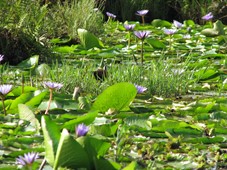
Lake Victoria, the largest tropical lake in the world holds a rich diversity of wildlife that supports the livelihoods of millions of people. The BirdLife partnership has identified 44 Important Bird Areas (IBAs) in the Lake Victoria Basin, and support from the Aage V. Jensen Charity Foundation is enabling community development planning to ensure natural resources are managed sustainably.
Lake Victoria is shared between Kenya, Uganda and Tanzania, with its huge catchment area also covering parts of Rwanda and Burundi. The swamps, forests and islands in and around it hold such a rich diversity of wildlife that the BirdLife partnership has identified 44 Important Bird Areas (IBAs) in the basin, out of a total of 1,234 for the whole of Africa.
The resources of the lake and its basin are also very important economically. Lake Victoria is Africa's largest inland fishery, and ecosystem services from the area support the wellbeing and livelihoods of millions of people.
The Lake Victoria Basin is therefore one of the most densely populated rural areas in the world, with high levels of poverty. The lake is threatened by pollution from domestic and agricultural waste, invasive species such as water hyacinth, uncontrolled burning and cutting of habitats such as reedbeds and forests, overfishing and excessive harvesting of birds and their eggs (Odada et al. 2004).
BirdLife partner in Kenya, Uganda, Rwanda and Burundi are working with communities in the Lake Victoria Basin to address the linked issues of biodiversity conservation and sustainable livelihoods. A key part of BirdLife's global strategy is to equip people with the knowledge, skills and technologies to develop their way out of poverty without jeopardising natural resources and biodiversity on which their livelihoods depend, and to empower these often marginalised communities to bring their concerns and interests into the attention of the authorities whose decisions affect them.
The BirdLife project supported by the Aage V. Jensen Charity Foundation is helping with participatory community development planning at IBAs in the Lake Victoria Basin, and strengthening community-based organisations to manage their natural resources more effectively. These local organisations are being linked into a regional network, enabling them to share their experience and good practice, and bring coordinated influence to bear on policy-makers.
Building on BirdLife's long experience of helping small local civil society groups through their early days, by the end of the project these new lakesides organisations should be stable, self-governing and self-sustaining, and able to ensure that their local livelihoods and natural heritage are adequately respected and protected for current and future generations.
Related Case Studies in other sections
Related Sites
Links
References
Odada, E.O., Olago, D.O., Kulindwa, K., Ntiba, M., and Wandiga, S. (2004) Mitigation of Environmental Problems in Lake Victoria, East Africa: Causal Chain and Policy Options Analyses. Ambio 33: 13-23
Pridham, C. and Langley, N. (2013) Living landscapes for nature and people. Celebrating the conservation work of the Aage V. Jensen Charity Foundation and the BirdLife Partnership. Cambridge, UK: BirdLife International pg. 16-17.
Compiled: 2015 Copyright: 2015
Recommended Citation:
BirdLife International (2015)
Conserving biodiversity through community action and sustainable development at Lake Victoria Basin.
Downloaded from https://datazone.birdlife.org/sowb/casestudy/conserving-biodiversity-through-community-action-and-sustainable-development-at-lake-victoria-basin on 22/12/2024